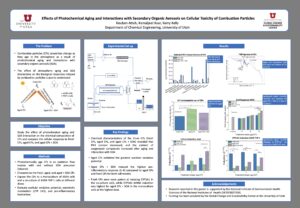The effects of photochemical aging and interactions with secondary organic aerosols on cellular toxicity of combustion particles
Bio
I am a Ph.D. candidate working in Dr. Kerry Kelly's lab. I came to the University of Utah to pursue my Ph.D. in Chemical Engineering after completing my MSc in Petroleum Engineering at the Institute François du Pétrole, France. I am passionate about solving energy needs in a clean and efficient way that is environmentally friendly. My research is focused on assessing the impact of emissions from conventional energy sources on human health.
Abstract
Fine particulate matter (PM2.5) is associated with numerous adverse health effects, including pulmonary, cardiovascular diseases and premature death. Significant contributors to ambient PM2.5 include combustion particles and secondary organic aerosols (SOA). Combustion particles enter the atmosphere and undergo an aging process that changes their shape and composition, but the impact of these changes on human health is poorly understood. This study aims to understand how atmospheric aging and interaction with anthropogenic SOA affect biological responses to combustion particles. The aged combustion particles exhibited the highest oxidative potential (acellular). Co-cultures of human epithelial A549 cells and THP-1 human macrophage-like cells exposed to aged particles coated with SOA exhibited the greatest inflammatory response (IL8). These co-cultured cells exhibited the greatest CYP 1A1 response to fresh combustion particles, which also contained the greatest mass of PAHs. These findings underline the significance of photochemical aging and SOA interactions on biological responses to combustion particles.
Narrative
My research cut across the field of energy, environment, and health. Fine particulate matter (PM2.5) derived from the combustion of various energy fuels is associated with numerous adverse health effects, including pulmonary and cardiovascular diseases and premature death. Significant contributors to ambient PM2.5 include combustion particles and secondary organic aerosols (SOA), which are derived from the oxidation of volatile organic compounds.

